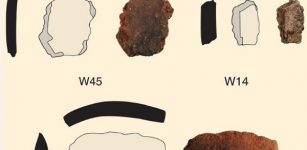Secrets Of The Lost Ancient Sahara Civilization
Ellen Lloyd - AncientPages.com - The Sahara is the largest desert in the world. At 3-1/2 million square miles, the Sahara is as large as the United States and covers one-third of the African continent.
With temperatures reaching 135 degrees and humidity as low as 2%, it can be not easy to imagine that this place was once a green paradise.
However, the Sahara, one of the hottest and driest places on Earth, was a wonderful place to live as recently as 10,000 years ago.
The Green Sahara was a lush savannah teeming with wildlife, grass, trees, and fish-filled lakes.
The region was inhabited by the lost ancient civilization of the Sahara.
For about five millennia, people thrived here, fishing, hunting, herding cattle, harvesting grain, and making pottery and jewelry. Then everything ended...
Sahara Was Once Green
About 8,000 to 10,000 years ago, a significant climate shift took place. It was caused by a variation in the angle of the tilt of the Earth and the shape of its orbit.
According to climate scientist Gavin Schmidt of NASA's Goddard Institute for Space Studies, around 8,000 years ago, the Earth's orbit was slightly different from how it is today.
Changes in the Earth's tilt cause changes in weather patterns. The tilt changed from around 24.1 degrees to the present-day 23.5 degrees. This change is believed to have made the "Green Sahara" dry.
Rains came to a virtual stop. People were forced to leave their paradise and migrate east to the Nile Valley. The new settlements there gave rise to the Egyptian civilization and the dynasties of the pharaohs.
Many ancient skeletons could be buried under the sand. Credit: Pixabay - alx4ndr3 - Public Domain
Hidden beneath the Sahara sand are traces of the civilization that once occupied this land. Archaeologists have recently begun to uncover clues to this lost marvelous world.
At over a hundred sites, scientists unearthed geological samples, animal bones, tools, and fascinating rock art, giving a dramatic and colorful picture of how life looked in the Green Sahara.
If we travel to the heights of the Tassili N'Ajjer in south-eastern Libya, the Hoggar, and the Air, we can still see trees like cypress and olive.
They have managed to survive, although they are unable to reproduce. Many of them are at least 4,000 years old. Roots extending 25 feet into the ground have kept them supplied with water.
Before the Sahara became a desert, the region also had trees such as ash, cedar, oak, walnut, myrtle, and lime.
Camels Were Unknown To The Ancient Lost Sahara Civilization
Camels are associated with the Sahara today, but the animal was unknown to the ancient civilization that lived here 10,000 years ago. Camels did not appear in this region until around the time of Christ.
Camels were unknown to the ancient civilization that lived here 10,000 years ago. Credit: Pixabay - pixelRaw - Public Domain
Various dinosaur fossils have been unearthed in this area. Giant beasts such as Ouranosaurus, Afrovenator, Jobaria, and several other species occupied this region in ancient times.
Other animals that lived here were reptiles and rodents. Both species are easily adaptable to the intense heat of the desert. They can find a tolerable temperature environment by hiding two feet below the surface.
In addition, reptiles can live without drinking as their digestive system breaks down dry plants to manufacture water.
One animal frequently seen here was the jerboa, also known as the desert rat. In addition to energetic burrowing, the jerboa could hop on its hind legs, sort of kangaroo-style, moving quickly over the surface.
Based on a large number of bones discovered, it is evident that crocodiles controlled the many rivers that are now long gone. The hare was also often encountered in the region. Being a good hopper, it could move fast and avoid burned feet.
Ancient Rock Art Reveal The Secrets Of The Lost Sahara Civilization
It is possible to learn much about the lost civilization from the incredible Sahara rock art that depicts thousands of years of forgotten history.
Prehistoric rock art in the Sahara is more detailed than the known cave paintings in France and Spain.
Modern man discovered the world's most extensive collection of fascinating cave paintings for the first time in 1842.
Prehistoric rock art of Tassili N'Ajjer. Credit: Salaheldine2300 - CC BY-SA 4.0
Heinrich Barth, a German explorer, spent five years examining thousands of prehistoric paintings in the region.
These ancient depictions were found in an area covering from Timbuktu in the west to Chad in the east.
In large caves inside the Tassilli N'Ajjer, in south-eastern Libya, Barth discovered thousands of paintings and engravings. Many of them were huge, and some were even feet tall.
The paintings depict how people of the area enjoyed this pre-desert paradise. We can view scenes from ancient daily life. Men are usually portrayed in hunting scenes, and women are seen combing their hair or dancing in circles.
There are many depictions of animals common in the region at this time. We find elephants, rhinoceros, lions, ostriches, giraffes, hippopotami, buffalo, and antelope.
The depictions of homes reveal that people lived in hemispherical grass huts. Several paintings also depict various pottery objects.
Ancient Sahara rock art. Credit: David Stanley - CC BY 2.0
People cultivated cattle. There are many depictions of calves, goats, sheep, and pigs. Domestic dogs appear as well. Fishing was also a widespread activity.
Many ancient secrets are buried beneath the sand of the Sahara. Scientists suspect there are large amounts of water under the sand, and the ancient remains of cities are most likely also hidden beneath the sand.
If you enjoyed this article consider becoming a member. Our member section offers a wealth of informative and insightful articles similar to this one. Upgrading to a premium membership gives you access to all our articles, including our library of ancient and unexplained mysteries.
Updated on August 3, 2024
Written by - Ellen Lloyd AncientPages.com
Copyright © AncientPages.com All rights reserved. This material may not be published, broadcast, rewritten or redistributed in whole or part without the express written permission of AncientPages.com
More From Ancient Pages
-
 Unknown Energy Source Created The Image On The Shroud Of Turin Scientists Suggest
Archaeology | May 12, 2012
Unknown Energy Source Created The Image On The Shroud Of Turin Scientists Suggest
Archaeology | May 12, 2012 -
 Mysterious Figurine Of Seated Olmec Woman With Polished Hematite Disk
Artifacts | Sep 12, 2015
Mysterious Figurine Of Seated Olmec Woman With Polished Hematite Disk
Artifacts | Sep 12, 2015 -
 Mystery Of The Ashkenazi Jews Found In A Medieval Mass Burial – Solved!
Archaeology | Aug 30, 2022
Mystery Of The Ashkenazi Jews Found In A Medieval Mass Burial – Solved!
Archaeology | Aug 30, 2022 -
 Discovery Of Chromosomes Offers Evidence Of Ancient Humans Living In South America Over 18,000 Years Ago
Archaeology | Aug 21, 2022
Discovery Of Chromosomes Offers Evidence Of Ancient Humans Living In South America Over 18,000 Years Ago
Archaeology | Aug 21, 2022 -
 Yamna Culture Started Cannabis Trade 5,000 Years Ago
Ancient History Facts | Aug 6, 2016
Yamna Culture Started Cannabis Trade 5,000 Years Ago
Ancient History Facts | Aug 6, 2016 -
 Magnificent Hattusa: Capital Of The Hittite Empire
Civilizations | Apr 11, 2021
Magnificent Hattusa: Capital Of The Hittite Empire
Civilizations | Apr 11, 2021 -
 2,000-Year-Old Roman Sandal With Nails Found In Germany
Archaeology | Jun 28, 2024
2,000-Year-Old Roman Sandal With Nails Found In Germany
Archaeology | Jun 28, 2024 -
 Treasure Hunters Encounter Something Unexplained In The Arizona Mountains
Featured Stories | Apr 7, 2022
Treasure Hunters Encounter Something Unexplained In The Arizona Mountains
Featured Stories | Apr 7, 2022 -
 Find Out Which Indigenous Lands You Live On With This Interactive Map Covering The Whole World
Places | Jan 17, 2023
Find Out Which Indigenous Lands You Live On With This Interactive Map Covering The Whole World
Places | Jan 17, 2023 -
 Upside Down Chambers For The Dead Found At Maeshowe, Orkney
Archaeology | Sep 8, 2020
Upside Down Chambers For The Dead Found At Maeshowe, Orkney
Archaeology | Sep 8, 2020 -
 Male-Female Roles 7,000 Years Ago Were Less Traditional Than Previously Thought – New Study Reveals
Archaeology | Jun 30, 2022
Male-Female Roles 7,000 Years Ago Were Less Traditional Than Previously Thought – New Study Reveals
Archaeology | Jun 30, 2022 -
 4,000-Year-Old Scottish Clava Cairns Were Built To House Dead
Civilizations | Nov 27, 2018
4,000-Year-Old Scottish Clava Cairns Were Built To House Dead
Civilizations | Nov 27, 2018 -
 Troublesome Momus: Deity Of Irony, Ridicule, Sarcasm And Harmful Jokes In Greek And Roman Mythology
Featured Stories | Mar 14, 2022
Troublesome Momus: Deity Of Irony, Ridicule, Sarcasm And Harmful Jokes In Greek And Roman Mythology
Featured Stories | Mar 14, 2022 -
 On This Day In History: Gutenberg Prints The First Bible – On Feb 23, 1455
News | Feb 23, 2017
On This Day In History: Gutenberg Prints The First Bible – On Feb 23, 1455
News | Feb 23, 2017 -
 Thousands Of Roman Coins Found Across Europe Are Fake – Archaeologists Say
Archaeology | Jul 9, 2019
Thousands Of Roman Coins Found Across Europe Are Fake – Archaeologists Say
Archaeology | Jul 9, 2019 -
 Artifacts From Shakhi Kora Reveal The Rejection Of Early Centralized Governance In Ancient Mesopotamia
Archaeology | Dec 9, 2024
Artifacts From Shakhi Kora Reveal The Rejection Of Early Centralized Governance In Ancient Mesopotamia
Archaeology | Dec 9, 2024 -
 Oshun Goddess Of Yoruba People Who Brings All Things That Make Life Worth Living
African Mythology | Mar 29, 2019
Oshun Goddess Of Yoruba People Who Brings All Things That Make Life Worth Living
African Mythology | Mar 29, 2019 -
 3,000-year-old pottery found in Papua New Guinea’s highlands
News | Sep 3, 2015
3,000-year-old pottery found in Papua New Guinea’s highlands
News | Sep 3, 2015 -
 New Moai Statue Found On Easter Island
Archaeology | Feb 28, 2023
New Moai Statue Found On Easter Island
Archaeology | Feb 28, 2023 -
 Rio Tinto Bosses Quit Over Destruction Of One Of The Earliest Aboriginal Sites
News | Sep 12, 2020
Rio Tinto Bosses Quit Over Destruction Of One Of The Earliest Aboriginal Sites
News | Sep 12, 2020





